SATURDAY
JULY 14 - 2018
Langstone
Nicola Hammond
reported on this morning's walk by the Havant Wildlife
Group.
A group of 11 met for a very convivial walk on, once
again, a gloriously sunny morning. Leaving from The
Ship at Langstone, we walked towards South Moor along
the coastal path. A number of whimbrel were seen, well
disguised on the Steve Hooper reline. Oystercatchers
were busy foraging. Large groups of mediterranean and
black headed gulls were also on the shore, plus grey
heron, little egrets and great crested grebe out in
the channel. A curlew was also heard. Looking inland
we saw skylark, linnet, meadow pipit and a kestrel. We
took a coffee break on the sea wall.

and watched a group of
swallows swooping over the field in front of us.
We took an inland path
to continue our journey and were delighted to see
house martins among the swallows. A great spotted
woodpecker was also seen flying over. Plus an
inquisitive Woodpigeon.

Gatekeeper and
speckled wood butterflies were numerous and we also
saw a painted lady, peacock and small skipper.
Thistles were in abundance, including creeping and
spear thistles and beautiful wild teasels. Shoreline
plants included sea purslane, buckthorn, ormwood and
lavender. Other plants seen included wild marjoram,
black knapweed, wild carrot, hogweed, woody
nightshade, ragwort, mallow, tansy, yarrow,
pineappleweed, gipsywort, mayweed and a sloe bush with
early berries.
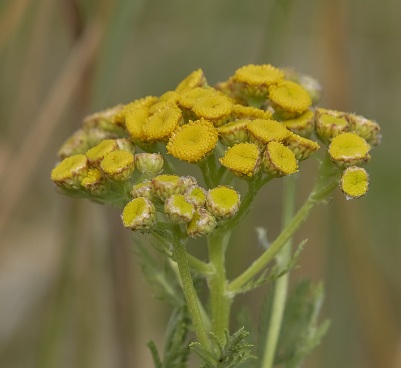
We ended the walk at
Langstone millpond where we saw the numerous little
egrets roosting in the trees.
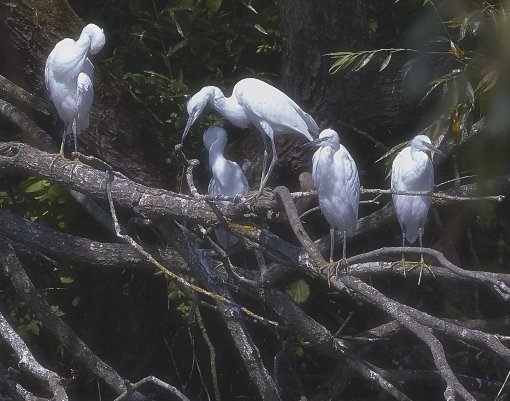
There were 'baby and
teenage' mallard duck families, mute swans, coot,
moorhens and a single female tufted duck. There were
also fine displays of hemlock water dropwort and hemp
agrimony. A very pleasant time was had by
all.
For more information
about this local group go to . . . Havant
Wildlife Group
News
from Cuba
Malcolm
Phillips has finally managed to get enough internet
connexion to send us some photos of wildlife in Cuba
where he is now living. He tells me the bird is a
Cuban Emerald Hummingbird, but does not know the
butterfly. Is anyone familiar with this insect? Also,
I wonder what that flower is?
FRIDAY
JULY 13 - 2018
Brook
Meadow - Annual cut
I went over to the Lumley gate where I found Colin
Brotherston struggling to open the lock on the gate
with what turned out to be the wrong key! Martin Cull
arrived and fortunately had bolt cutters in the
tractor and was able to cut the chain easily and open
the gate. Pam Phillips arrived later with the right
key. Here is Martin finally driving through the
gateway.

It was good to see
Martin back as he knows the meadow very well and
always does a good job. He did not come last year when
the cutting was done by Norse. Here are the three of
us posing for photo - taken by Tricia Brotherston.

Colin and Martin
consulting the cutting map
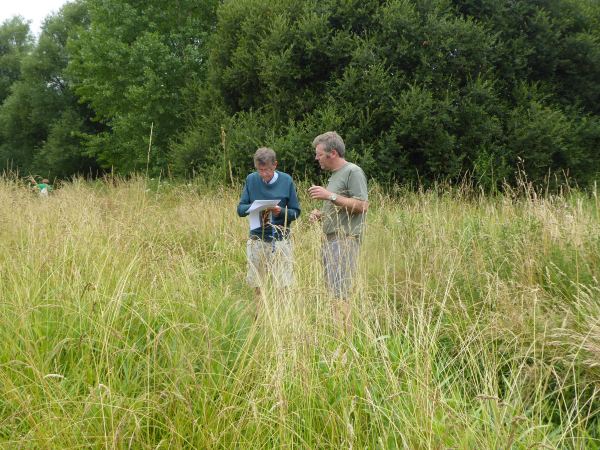
Martin made a start on
the centre meadow.
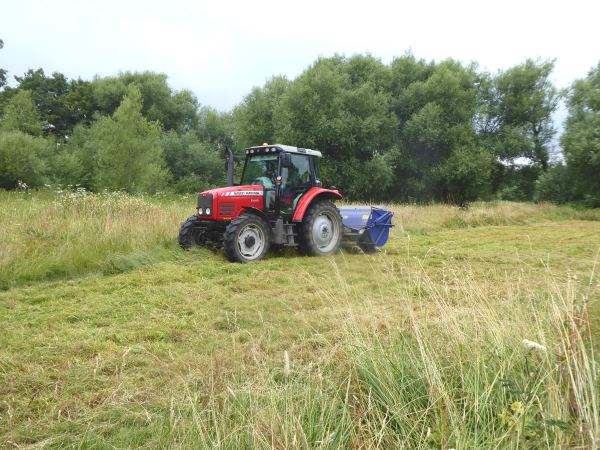
Video
clip of Martin at work with his sturdy red
tractor . . .
https://youtu.be/5PJt6lVUpT4
Meanwhile Colin,
Tricia and Pam Phillips searched the long grasses of
the centre meadow for the tree stump which Martin
wished to avoid! We finally found the stump and marked
it clearly so Martin could easily avoid it with the
tractor. For future reference the stump is about half
way along the cross path from the Lumley gate - Grid
Ref: SU 75119 06022.
Here
is Tricia standing on the
stump

Martin disturbed a
wasp nest during the cutting of the centre meadow. I
went home to prepare a notice warning visitors about
the nest and Pam also did one.
I went back after lunch to find that Martin had just
completed cutting the centre meadow and was starting
on the north meadow. He said he would not finish today
and offered to come again next week. Colin will
confirm with him.
Video
clip of Martin at work on the north
meadow . . .
https://youtu.be/b3iPqBOLh8M
Video
clip of Martin dumping cuttings in the far corner of
the north meadow .
. . https://youtu.be/OcOZONnNyqA
Wildlife
observations
Plants in
flower for the first time: Bristly Ox-tongue,
Selfheal, Hemp Agrimony, Square-stalked St
John's-wort.
The bright red flowers
of Great Burnet are still showing well on the
south end of the orchid area.

There is a fine
display of Meadowsweet this year.

I also had what I
thought was a Clouded Yellow butterfly feeding on
Common Fleabane on the orchid area. It was
particularly pale yellow which should have alerted me
to my mistake. I am grateful to Ralph Hollins who
pointed out that the butterfly was in fact a summer
brood Brimstone.

Ralph points out . . .
"The two sharp points on the rear edge of the closed
wing of your butterfly show it to be one of the first
of the 2019 brood of Brimstones.
See https://butterfly-conservation.org/butterflies/brimstone
and scroll down to the foot of that page to see a
photo of a Clouded Yellow under 'similar species' -
note the absence of the distinctive points on the rear
edge of the closed wing.
THURSDAY
JULY 12 - 2018
Great
Black-backed Gulls
I popped down
to Slipper Millpond this morning to check on the Great
Black-backed Gull family that must be almost ready to
move off after their 7th consecutive nesting year on
the pond. The family with one adult and two well grown
chicks were on the north raft for a change. The chicks
must have flown there from the centre raft where I saw
them last and it can't be too long before the whole
family moves off the pond.
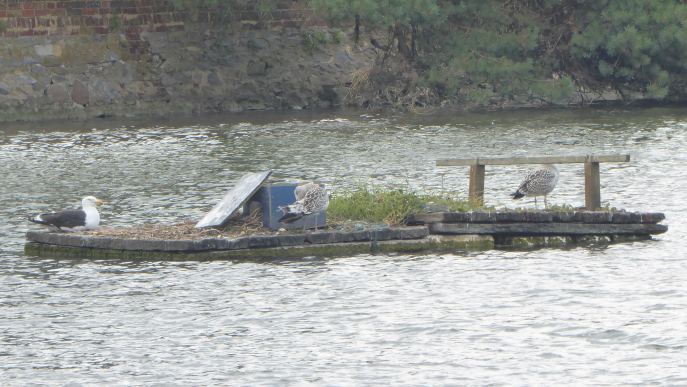
TUESDAY
JULY 10 - 2018
Pigeon
at sea
James
Collings-Wells had an interesting experience while
sailing on a windy day between Guernsey and the north
Brittany coast when what was presumably a racing
pigeon came to rest on his boat. James had seen it
land in the water a couple of times and assumed it was
a Razorbill or Guillemot (plenty around), until it
started circling the boat.
It spent a couple of hours with them, breakfasting on
oats and water. Eventually, James was obliged to chase
it out of the cabin after it started eating the
remains of his breakfast off the frying pan. Another
pigeon appeared on the return journey, again landing
in the water, but this time seemed unable to judge a
landing on the boat. Lots of gannets and dolphins
too.
Here is James's
photo of the pigeon feeding on the boat

It is not unusual for
pigeons to come down to the ground or onto boats for a
rest while racing. They can usually be identified from
the ring on their leg. James's bird has a blue ring
with numbers on its right leg.
I sometimes see a stranded racing pigeon in Emsworth
in the harbour or on the millponds. Only a couple of
weeks ago Anne Moodie saw one on the edge of Peter
Pond in Emsworth (see this blog for June 30). The
Royal Pigeon Racing Association have a special page
about how to deal with stray racing pigeons and how to
report them.
See .. . . https://www.rpra.org/stray-reporting/
MONDAY
JULY 9 - 2018
Waysides
News
I had a walk
around some of the local waysides this afternoon. I
started at Washington Road and walked under the two
bridges to check on the Greater Burdock which
has been on the grass verge by the pony field just
before the entrance to Emsworth Recreation Ground for
many years. I am pleased to report the plants, of
which I counted a good 40 or more, are in very good
shape, despite (or maybe because of) being mown to the
ground by the Council cutting team last autumn.

The easiest way to
distinguish Greater Burdock from the more common
Lesser Burdock (without having to perform surgery) is
by the shape of the flower clusters; in Greater the
flowers are in flat-topped clusters whereas in Lesser
they are arranged at various levels along the top of
the stem.

Here
is a short video clip I made of the Greater Burdock
plants . . . .
https://youtu.be/0oSKyHGy_pA
From there I walked
across the Recreation Ground to have a look at the
wayside on the far north west corner of the park.
After a bit of searching I managed to find some Meadow
Barley well past its best, but is still there, in
front of the fallen tree stump by the metal gate. Much
better was the excellent crop of what I am fairly sure
is Smaller Cat's-tail (Phleum bertolonii) -
much smaller than the more common Timothy (Phleum
pratense).

Next I went over to
Christopher Way where I found the small section of
verge housing Wild Clary left uncut by the
Council cutting team - the other verges were shaved to
the bone! I think the cutting team have now got the
message that this is a special piece of verge.

The plants themselves
are now setting seed and I collected some to spread
onto other sites.
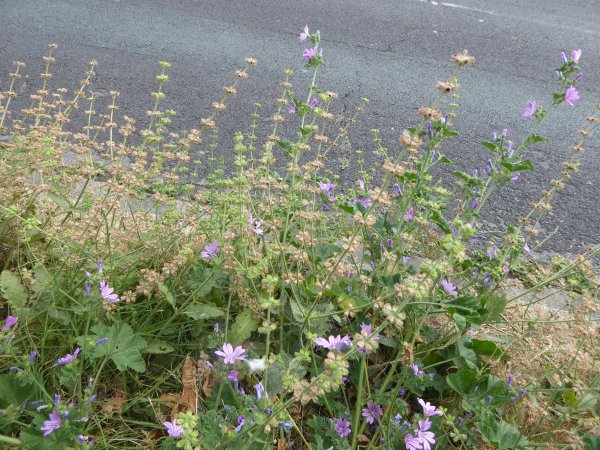
Interestingly, this
little section of verge, no more than 10 metres long.
also supports a variety of other flowering plants
including, Common Ragwort, Common Mallow, Common
Cat's-ear, Ribwort Plantain, Smooth Hawk's-beard and
False Oat-grass.
Smooth
Hawk's-beard

Finally, I had a look
at the Railway Wayside to the north of Emsworth
Railway Station from the access ramp. Sadly, it
appears to have lost most of the Marsh
Woundwort that was so prominent on this site a few
years ago. This attractive plant is now largely
restricted to the area around the newly erected
bicycle park where there is less competition from
tougher plants.

However, there is
still plenty of interest to see from the ramp (I did
not venture onto the site itself which requires
squeezing through railings), including masses of Great
Willowherb, Hoary Willowherb, Yarrow, Hedge Bedstraw,
Perforate St John's-wort, Stone Parsley, Bramble,
Creeping Thistle, Common Ragwort, Wild Carrot, Common
Fleabane, Hemp Agrimony (first of the year). Common
Knapweed, Hedge Bindweed.
Upright
Hedge-parsley

Blue
Water-speedwell
Martin Rand
has confirmed yesterday's identification of the Blue
Water-speedwell:
"The
flower colour and the erect flowering branches look
good for V. anagallis-aquatica. (The
hybrid usually shows some purply-pink in the flowers,
although it's variable, and the flowering branches are
not only longer but more wayward and spreading in the
hybrid. ) Once you have (or in the case of the hybrid,
don't have) fruits, it's easy. If you do find any
fruiting capsules in the hybrid they are usually
obviously notched like V.
catenata.

SUNDAY
JULY 8 - 2018
River
view
Jean and I had
a walk through Brook Meadow this morning mainly to
have a look at the view of the river from the south
bridge following the removal of the fallen Goat Willow
tree by Brook Meadow volunteers yesterday. Previously
the tree had been blocking the view from the bridge,
but its removal has opened up the view of our lovely
river, snaking through the copse. Well done to Maurice
Lillie and his team of volunteers.

Link to Maurice's
report and photos of the work at . . .
https://www.brookmeadow.org.uk/conservation-news/
Blue
Water-speedwell
During the
morning walk I noted two very good clumps of what I
assume is Blue Water-speedwell (Veronica
anagallis-aquatica) in the river. One clump is
just before the bend in the north river by the railway
embankment. The other clump, a much larger one than
the first, is on the river bank in front of where the
old gasholder used to be. Both can easily be seen from
the main path, though not easily reached.
I have recorded this
interesting plant both on the Lumley Stream and on the
River Ems over many years. In fact, I found a small
sample near the Lumley Stream earlier this year.
However, care needs to be taken to establish its
correct identification.
Basically, I need to
determine if these plants are of the pure strain of
Blue Water-speedwell (Veronica
anagallis-aquatica) or a hybrid with Pink
Water Speedwell (Veronica catenata)
called Veronica x Lackschewitzii. The
only sure way I know how to determine this is by
counting the flowers in the spike. Basically, the
hybrid form has a longer flower spike containing many
more flowers than the pure form. I shall have to get
one of the more agile volunteers to clamber down the
river bank to collect a sample for me to examine.
Pete Selby (the late
BSBI South Hants Recorder) told me during a visit to
Brook Meadow in 2001, that if the flower spike had
more than 20 flowers then it was the hybrid and not
the pure form of Blue Water-speedwell. At the time,
Pete found the plants were mostly hybrids, though
since then I have had many examples from the meadow
with less than 20 flowers in the spikes which I have
recorded as the pure form of Blue Water-speedwell
(Veronica anagallis-aquatica). Looking at the flower
spikes on the larger clump in my zoomed photo they
seem to have fewer than 20 flowers, though I really
need to see a sample to be sure.
Zoomed
close-up of the Blue Water-speedwell flowers

Interestingly, the
Plant Crib (1998 p. 263) gives a mean of 25 flowers
(range 15-40) for the pure form and a mean of 60
(range 30-90 for the hybrid, so maybe the 20 limit is
probably not quite as precise as Pete implied.
Scarce
Tortoiseshell
Ralph Hollins
drew my attention to a possible Scarce Tortoiseshell
butterfly (Nymphalis xanthomelas) - also
known as Yellow-legged Tortoiseshell - which was
reported at Newhaven, on June 30, possibly as part of
an invasion from the Far East.
The facts can be read in a Butterfly Conservation
report written in the spring of 2015 but Ralph thinks
they could be relevant in the current hot weather. He
says a sighting of one in Brook Meadow would bring
more kudos than the Kookaburra! Yes, yes!
See . . .
https://butterfly-conservation.org/news-and-blog/continental-crusader-conquers-british-winter
The Scarce
Tortoiseshell is very similar in appearance to the
very common Small Tortoiseshell. The Scarce
Tortoiseshell has yellow or straw-coloured legs (not
brown) and a yellow patch on the top corner of its
upper forewing instead of white. So look carefully at
your Small Tortoiseshell photos just in case . . .
Mystery
moth
Roy Hay had
this small moth in a stairwell in his house near
Fishbourne Meadows this morning - attracted by the
lights at night, Roy thinks.

Having trawled through
my insect books and Google my guess is that it is a
male Four-spotted Footman (Lithosia
quadrata). This is a sexually dimorphic
species and is resident along the south-west coast of
England and Wales and is also an occasional
immigrant.
Only the female has spots which give the species its
name. The male is much smaller than the female and has
a distinctive orange head and grey wings. The larvae
feed on lichens on the bark of deciduous trees. It
flies from July to September.
I would appreciate confirmation.
Millpond
News
Chris Oakley
was down at Slipper Millpond today and found a family
of Mallard ducklings on the pond. They are not
likely to survive long with the Great Black-backed
Gull family with two hungry chicks also on the pond.
Chris also spotted a shrub with evil looking thorns.
It looks like Buckthorn to me though I would
like confirmation.
SATURDAY
JULY 7 - 2018
BROOK
MEADOW
Tree removal
I went down to
the south bridge for 10am where I found Maurice Lillie
and his team of 4 volunteers (Nigel, Terry, Reg and
Phil) had already made a start in removing the Goat
Willow tree that had fallen across the river some time
ago seriously blocking the view of the river from the
bridge. As it was my suggestion that the tree should
go, I had an extra obligation to be present. I
basically stood on the south bridge for an hour
watching and taking photos and videos of the
volunteers at work.
Me
relaxing while the others
worked.

The job was completed
in about 1 hour which was very good going. Excellent
team work. One can now see the River Ems again from
the south bridge, though the river banks are still
overgrown. This must be the most poplar viewpoint on
the meadow.
Maurice
in the bushes togged up in his waders reading for
action!

Volunteers
at work: Nigel, Terry, Reg, Maurice and
Phil
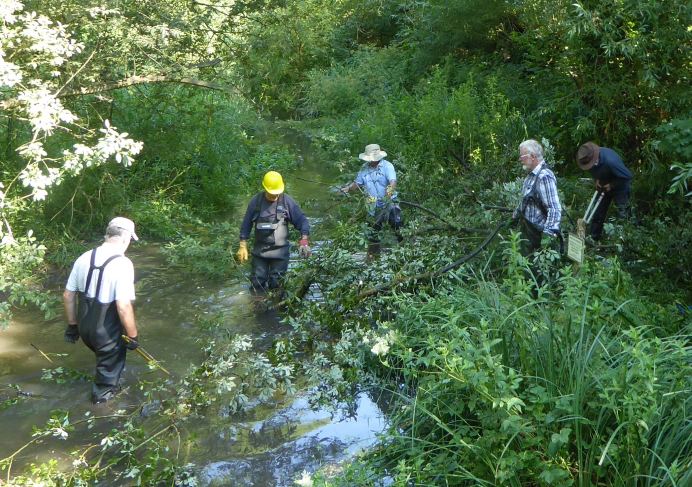
Job
finished. Well done lads! (Nigel, Maurice, Phil, Reg
and Terry)
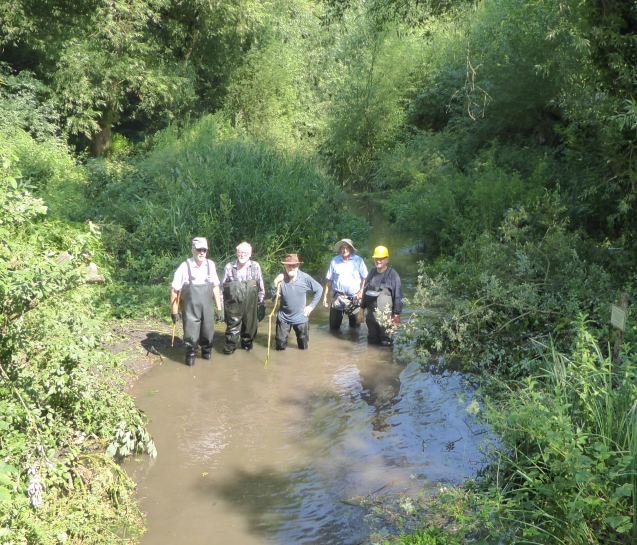
Here are links to a
couple of videos of the work in progress . . .
This shows the work at
the start . . . https://youtu.be/MwbbpMLdJRg
This shows the work
almost complete . . . https://youtu.be/JTJ7QGG0VyA
Wildlife
observations
While I was on
the bridge I kept my eyes open for anything of
interest. Male and female Beautiful Demoiselles
were constantly fluttering around and occasionally
perching on the leaves of Fool's Water-cress on the
river They were joined by a cracking Comma
butterfly. Lots of Whites were fluttering around,
though none of them stopped.
Link to video of the
male Beautiful Demoiselle . . . https://youtu.be/HlqX0waarx8
and to the Comma . . .
https://youtu.be/9NZilobO7Ew
Fool's
Water-cress is now in flower below the
bridge.

Coming back through
the meadow I saw several Large and Small Skippers. So
far this year I have recorded 16 species of butterfly
on Brook Meadow. Surprisingly I have yet to see
Ringlet, Small Tortoiseshell and only one Common Blue.
Has anything happened to them? Also, I am sure there
are Ringlets among all the Meadow Browns, but I have
not managed to get one to settle long enough for a
photo.
Peter's
early morning
Peter
Milinets-Raby found it too hot to sleep, so he came
over to Brook Meadow at 5:11am (just after
sunrise) until 6:20am. It was a beautiful morning, but
alas no sight or sound of Ring-necked Parakeet or the
Kookaburra.
Birds of note were 3+ singing Blackcap, Green
Woodpecker (heard) Great Spotted Woodpecker seen, 5
Swallow over, 2 Med Gulls over, 2 Common Tern over and
a Swift.
On Peter Pond 1 Kingfisher and 2+ Reed Warbler
singing
On Slipper Mill Pond - 1 adult and 1 juvenile
Great Black-backed Gull and 2 Mute Swans with 3
cygnets.
Emsworth Harbour (from 6:21am to
6:53am): 2 Med Gull, 1 Little Egret, 1 Cormorant, 12+
Juv Black-headed Gulls, 5 Shelduck, 1 Greenshank, 30+
Curlew.
Langstone Mill Pond (from 7am to
7:22am): 7 Med Gull, 39 Little Egret, 2+ Reed Warbler
singing.
Portsdown
Hill
Ros Norton
reported on this morning's walk by the Havant Wildlife
Group
See the following link
for the full report . . . http://familyfellows.com/hwg-walk-reports-2018.htm
Romney's
Hedgehogs
Romney Turner
has been getting a number of Hedgehog in her garden
and sent me photos of then around the food tray
containing peanuts, sunflower hearts and dried
mealworms. Romney thinks the ones on the right are
twins from last year.
THURSDAY
JULY 5 - 2018
Rare
birds
The
Blue-winged Kookaburra was seen for the second
day running on Brook Meadow, in much the same place
near the main seat overlooking the meadow. Jean-Pierre
Roberts saw the bird fly across and perch on a tree. I
went over this evening to have a look for it, but did
not see it. However, it is a fairly large and brightly
coloured bird and should be easily visible, so please
keep a look out and let me know if you see it.
Kookaburras are native to Australia, but kept as
avairy birds in this country. Here is yesterday's
photo of the bird perched by Marion
Emberson.

Rose-ringed
Parakeets are not exactly rare birds, though they
are not often seen this far south. They are native to
India, but introduced into this country in 1969 and
are now firmly established in the South of England,
especially the London area. Pam Phillips has had one
in the Rookery in the last few days and has heard its
distinctive loud screeching call and a neighbour has
seen the bird. So, another one to look out for. Here
it is just in case you have not seen one. They are
sometimes called Ring-necked Parakeets.

Garden
Woodpecker
This juvenile
Green Woodpecker is a frequent visitor to Barrie Jay's
garden in Waterlooville. Lucky chap. Barrie that is.

Young
Terns on the Oysterbeds
Christopher
Evans and Doug Yelland were at Hayling Oysterbeds this
morning for this month's Havant U3A Birdwatching Group
walk. Wez Smith (the RSPB warden) had just arrived and
again rowed out to the tern raft with the aim of
attaching a wooden pallet alongside, as a launching
point for the fledgling Common Terns en route to the
bank immediately behind the raft. They could see that
a number of young Terns were already over there and
whilst we were there, saw one struggle
across.
WEDNESDAY
JULY 4 - 2018
Brook
Meadow
I spent a
couple of pleasant hours on the meadow this afternoon.
The weather was slightly cooler than of recent with a
cooling breeze.
Reptile mats are now out across the meadow for the
reptile survey with a view to the relocation of
Slow-worms and Common Lizards onto the meadow from a
building development in Warsash.
I spent some time mooching around the Lumley area
where I found several newly flowering plants for this
year; Red Bartsia, Common Fleabane, Common Knapweed,
Perforate St John's-Perforate and Square-stalked St
John's-wort
Red Bartsia . . .
Common Fleabane . . . Common Knapweed . . . Perforate
St John's-wort
along with masses of
Sharp-flowered Rush.
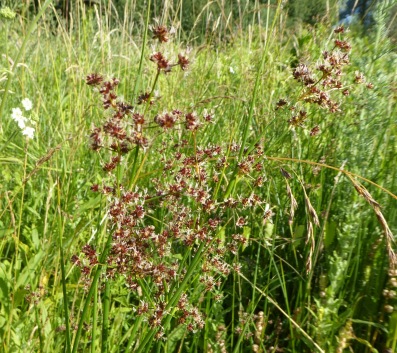
I added False
Brome to the grasses list for this year on the
north path where Ground-elder is also now in
flower at the eastern end of the path near the steps
down to the meadow. However, I could not find any
Meadow Barley or Smooth Brome despite a lot of
searching.
Best sighting was my first Marbled White of the
year fluttering around over the Lumley area. It did
not stop for me to get a photo, but here's one taken
on the meadow by Malcolm Phillips a couple of years
ago.

I came across this
patchy young Blackbird on the path in front of
me. Blackbirds often have these pale areas in their
plumage.

Kookaburra
on Brook Meadow
I had this
fascinating photo from Marion Emberson which she took
at 9am this morning on the meadow in the trees by the
River Ems. Marion could not identify it, but I
immediately recognised it as the Blue-winged
Kookaburra which had recently been seen in an
Emsworth garden and reported in the Portsmouth News
(see this blog for June 25). Now, hey presto, it has
turned up on Brook Meadow. The owner of the aviary,
from where the bird must have escaped, would want it
back as the bird apparently is quite valuable -
£500 to buy!

"Kookaburra sits in
the old gum tree,
Merry, merry king of the bush is he
Laugh Kookaburra, laugh
Kookabura. Gay your life must be!"
TUESDAY
JULY 3 - 2018
Hollybank
Woods
Another hot
day, so I decided to head for the woods to look for
White Admirals. The woods were wonderfully cool and I
walked slowly around the eastern section stopping at
some White Admiral 'hot spots' that I knew from the
past.
There was not sign of any Admirals, but I did get a
good view of a magnificent Silver-washed Fritillary
fluttering high in one of the Sweet Chestnut
trees. Unfortunately, it did not perch for me to get a
photo so here is one that I got a couple of years ago
in these woods. The upper wings are deep orange with
dark streaks. The underwings have wishy-washy silvery
streaks from which the butterfly gets its common name.
The Sweet Chestnut
trees are currently adorned with masses of long
pale yellow catkins, with equal numbers having already
fallen to the ground.

I found lots of what I
assume to be Common Bent-grass along the edges
of the paths, distinguished by their open spreading
panicles and short ligules. Common Bent is more
characteristic of woodland than Creeping Bent which is
seen mostly in grasslands.

I had a magnificent
Southern Hawker dragonfly buzzing me on the
main path as they often do - curious creatures. I did
not get a photo, so I have included one taken a few
years ago.

Langstone
Mill Pond
Peter
Milinets-Raby visited the Langstone Mill Pond this
lunchtime (1:38pm to 2:15pm - tide pushing in)
Just 2 Greenshank present, with 1 Redshank. Both
Greenshank had colour rings on RG//- + YY//- (a
regular from 2013 onwards). B//R + LL//- (Never seen
this bird before - a classic passing through bird!).
Also present were 7 juvenile Black-headed Gulls (no
juv Meds yet, though only a matter of days). 1 Sand
Martin with 4 Swallow over the pond
17+ Juv Little Egrets scattered around the pond and
out of nets - the colony is getting very quiet now. 3
male and 2 female Tufted Duck and still one Reed
Warbler singing.
MONDAY
JULY 2 - 2018
Langstone
Mill Pond
Peter
Milinets-Raby popped down briefly to Langstone Mill
Pond this lunchtime just as the tide was pushing in
(1pm to 1:40pm - bright sunshine, baking hot!). The
highlights were 6 Greenshank, 3 Redshank, a Curlew and
a Lapwing. Also off shore was a Great crested Grebe
asleep with leg out cooling itself down. On the pond:
2 pairs of Tufted Duck

SUNDAY
JULY 1 - 2018
Brook
Meadow
Workday - I
went over for the regular 1st Sunday in the month
workday, walking very slowly in the heat. Good turn
out of 12 led by Jennifer Rye. Jennifer's brother Nick
was there, so I asked him to take the group photo with
me in it for a change!

The main jobs were
cutting the casual paths and the two experimental
areas on the north meadow using the power scythe and
clearing the arisings. The twig barrier around the
orchid area was also removed - photo shows volunteers
at work.

Video clip of
volunteers removing twig barrier around the orchid
area . . . https://youtu.be/btItgbVhzuA
Video clip of
volunteers raking northern experimental area . . .
https://youtu.be/ef9xqO3-hzY
For the full report
plus more photos and videos go to . . .
https://www.brookmeadow.org.uk/conservation-news/
SATURDAY
JUNE 30 - 2018
Night
visitors
I put the
trail camera out in the back garden as usual last
night, but nothing of special interest arrived. There
was no sign of the Fox, but plenty of cats came
through the garden during the night and early morning,
including several visits from Oswald from next door,
sniffing around the food dishes. I will try not
leaving any food out for a while as this clearly
attracts the cats. Woodpigeon arrived at 05.08,
followed by Magpie and Blackbird.
Gull
chicks are flying
Sharon Corbett
whose house overlooks Slipper Millpond saw the first
flight of the Great Black-backed Gull youngsters today
- about 10 metres. That's good news. It may well be a
couple of weeks or so before they finally leave. Nice
healthy youngsters.
Swifts
Anne de Potier
is now regularly seeing swifts feeding over SW
Emsworth. The most so far is at least 18 last Sunday.
She didn't see more than the odd one until abut 2
weeks ago. We have also been seeing some over Bridge
Road - not more than 7, but so good to see. Hope
numbers build up. I want to see families screaming
around the houses again!
Mystery
bee is a Leaf-cutter
Sue Thomas is
now pretty sure that the bee in her garden plant pot
that I thought might be a mining bee is in fact a
leaf-cutting bee. She has seen the bee making a second
tunnel in the same pot but under a different plant.
She followed it around the garden where it went
straight to the Wisteria and it cut a leaf. Then it
rested on an old pot where Sue got a close up photo.
Sue's research leads
her to a leaf cutting bee called ... Megachile
willughbiella, or Willughby's Leaf-cutter
Bee. Reading its life history explains why in May
Sue suddenly had a dozen bees in the conservatory.
They must have hatched from one of the succulent plant
pots and had over wintered inside. Well done, Sue. A
nice bit of detective work!
Mystery
Dove
Anne Moodie
spotted this unusual pigeon on the edge of Peter Pond
in Emsworth and wondered if it was a Turtle Dove.
Well, it certainly is not a Turtle Dove and the fact
that it has a ring on its leg suggests it is an aviary
escape or maybe a racing pigeon of some sort? Has
anyone any other ideas?

Noar
Hill
Heather Mills
reports on this morning's walk at Noar Hill
Nigel and Rosie kindly made a trip out to Noar Hill to
guide us around this morning to witness the amazing
flora available at this wonderful site. Four of our
group arrived and Nigel brought 2 friends along with
Rosie. A local lady also had contacted Nigel and
joined us. Later we had a small gathering looking at
the Frog orchids. A Kite quickly flew over and
disappeared before the group saw it but we did catch
up with at least 6 Yellowhammers constantly belting
out their song up and down the perimeters.
The Common, Fragrant and Pyramidal orchids were very
much in abundance with a good showing of Musk together
with Tway blades and Frog orchids. Dragon's tooth had
a couple of flowers in the usual pit almost at the
extremity of the pits, but was overshaddowed by the
long grasses. The highlight would have been a Fly
orchid, but sadly even since Nigel did his recci on
Wednesday, it had gone over.
Dragon's Teeth .
. . Frog Orchid . . . Twayblade
Butterflies gave us a
summer spectacle with all the usual specimens at this
time of year except any blues, and I think I had a
first Brown Hairstreak. A Southern Hawker gave good
views when it alighted and stopped hawking along the
footpath in front of some of the group. We did notice
that ticks were very much in evidence when some sat on
the grass for a break!
A very pleasant time
was had by all and thanks to Nigel and
Rosie.
FRIDAY
JUNE 29 - 2018
Night
visitors
I put the
trail camera in the garden over night in the same
position as before, but a bit closer to the feeding
area. I did not put out any Hedgehog food, which the
cats got most of last night, but just did a simple
dish of bird seed, which would be of no interest to
cats but which may interest the Fox. I was right. All
four of my neighbouring cats came through as usual,
sniffed around, but ignored the seed. The Fox actually
came in much earlier than before, at about 10.48pm,
and seemed a bit disappointed not to have any tasty
food in the dish. However, it stayed for a couple of
minutes, nibbling seeds, then left.

Video
clip of the Fox
. . https://youtu.be/5MlY0748u3A
Swifts
We have had 7
Swifts flying over the gardens in Bridge Road couple
of times today. Best so far this year. My son phoned
me from Cowes on the Isle of Wight last night to say
he was watching at least 20 Swifts screaming around
the houses. So they are about, but not here!
Hermitage
Millponds
I cycled down
to Slipper Millpond this morning where I found the
Great Black-backed Gull family ensconced on the
large centre raft with two well-grown juveniles and
one adult in attendance. The family will be moving off
the pond, once the youngsters are fully fledged and
flying. I have not yet seen them in flight.

Video
clip of the gull family . .
. https://youtu.be/-mJsa7oX82s
Meanwhile the
abandoned nesting south raft boasts a fine clump of
yellow daisies, which look like Perennial
Sow-thistle.

I found the Mute
Swan family in a small enclave on the east side
Peter Pond. The family is now down to 3 cygnets,
following the loss of one cygnet from an attack by a
dog last weekend in Dolphin Lake.

The remaining cygnets
are being well guarded by the parents, but dog walkers
certainly need to take special care to keep their dogs
on leads when near the ponds, particularly at this
time of the year.
Video
clip of the swan family . . . https://youtu.be/oo3z4KqkwGM
Brook
Meadow
Coming back
through the meadow was stiflingly hot, but I stopped
long enough to identify two types of Bent grass on the
cross path from the Lumley gate - Black Bent
and Creeping Bent. One Black Bent plant was at
least 130cm tall, the usual limit in the books is
120cm. Here is a panicle of Creeping Bent-grass (I
think) - such a lovely delicate grass.

A female
Demoiselle (probably Beautiful Demoiselle) was
flying around beneath the south bridge, occasionally
coming to rest on the leaves of Fool's Water-cress on
the surface of the river. No sign of a male.

Walking through
Palmer's Road Copse, I found a good growth of
Gipsywort on the west bank of the river
opposite to where the centre path emerges from the car
park. It was not yet in flower. Its leaves resemble
those of Common Nettle but do not sting.

Mining
Bee
Sue Thomas has
been witnessing some strange bee behaviour in her
garden. In her own words . . .
"We
have been watching an interesting event taking place
in a plant pot full of succulents that is on our
outdoor dining table. Firstly we wondered how little
stones that were in the pot became strewn over the
table. Then yesterday evening as we had our meal we
watched a bee coming and going to the edge of the pot.
Investigating there seems to be a little tunnel
underneath a plant. The bee flew in one side and
bustled about then flew out on the other side. It
seemed to be pushing and scraping. This morning at
breakfast...so warm we took our cereals to eat
outside!, and the bee was to and fro again but each
time carrying a piece of green leaf. A very exciting
breakfast for us and something we have never seen. We
do not know what bee this is, whether we are seeing
the same bee each time or whether there are two bees.
I enclose a photo or two but the bees are blurred as
always on the move. I'd love to know more. Can you
help?"
Sue's bee is almost
certainly a so-called mining bee. Mining Bees are
solitary insects which nest in burrows in the ground.
Unlike social bees they don't live in colonies.
Instead each mining bee female digs an individual
burrow to rear her young. They are not aggressive and
are good for the garden. They pollinate the flowers
and their digging can aerate the soil. They are one of
the largest groups of solitary bees with 1,300 known
species in the world! One of the most common is the
Tawny Mining Bee (Andrena fulva)
which is what Sue's might be, though this is just a
wild guess. Any other information would be welcome.
THURSDAY
JUNE 28 - 2018
Night
visitors
I put my new trail camera out over night in my back
garden again in the same position as before, but this
time pointing towards a dish of Hedgehog food that I
purchased from the local Garden Centre. Gosh, it
really did pong! Well, the food certainly attracted
plenty of attention from the local cats who were on to
it very promptly. By midnight at least two cats had
been sampling the Hedgehog food.
I think by the time the Fox arrived on the scene at
05.33 most of it must have gone. The fox stayed for a
few minutes licking up the remnants and nibbling at
the seeds on the ground, closely watched by my
neighbour's cat called Oswald! After the Fox had left,
Oswald the cat had a sniff around but the dish had
been licked clean by then.

Here are links to
video clips taken last night of the Fox and Oswald
looking on tentatively
. . . https://youtu.be/QSyoQpzFXsU
. . . and . . . https://youtu.be/JWYd8g9sh9A
Birds were the final
visitors, led by Woodpigeon and House Sparrows.
Overall, this camera really gives a fascinating
glimpse of the goings on in my garden during the night
and early morning.
Brook
Meadow
I popped over
to the meadow this afternoon mainly to check on the
Great Burnet which Colin Brotherston had
photographed earlier this month and which I had
missed. I can't understand how I missed such a good
crop of about 20 plants all covered with multiple
flower heads at Grid Ref: SU 75071 06132 which is
roughly where they have been for the past 5 years -
first discovered and confirmed by Martin Rand in 2013.

Close by I was also
pleased to find the first of the Timothy grasses,
always a relatively late grass to flower, but so
elegant with extraordinarily long vertical and
cylindrical inflorescences - up to and sometimes over
15cm long.

Here is a link to a
video clip of the Great Burnet flowers and the Timothy
. . . . https://youtu.be/hsUTEPViAqU
The single
Pyramidal Orchid is still showing very well in
the centre of the orchid area - marked by a tall stick
if you want to see it before it goes.

I had a rest in the
shade on the main seat from where I saw 5 Carrion
Crows fly over towards Palmer's Road Copse,
presumably a family of three youngsters from this
year. The berries are gradually turning red on the
Alder Buckthorns on the causeway.

Interesting to see how
False Fox Sedge is now coming up in various
parts of the meadow, not just on the Lumley area.
I struggled down the
narrowing path by the old Bramble hedgerow on the east
side of the south meadow where I found the first
Black Bent-grass (Agrostis
gigantea) of the year - regular in this
location. As indicated by its scientific name this is
a large grass, the tallest of the Bents up to 150cm
with panicles about 20cm. Its large size probably
allows it to survive among the tall vegetation along
this path.
Nearby are some
buttercups with reflexed sepals which I am fairly sure
is Hairy Buttercup (Ranunculus
sardous) - which has been more evident in the
this area in previous years.
Finally, a Large
Skipper was flying in the south east corner of the
south meadow. This used to be a good spot for Essex
Skipper, but this was definitely not one as shown by
the heavy markings on the wings.

WEDNESDAY
JUNE 27 - 2018
Fox
returns
I put my new
trail camera out in the garden again last night, this
time on a setting to take both still photos and
videos. The fox, presumably the same one that I
recorded two night's ago, was back as before feeding
on bird seed scattered on the grass. The camera took
several shots and short videos of the Fox. It arrived
at about 3.47am and stayed for just over 10 minutes.
As it was dark the infrared light was activated. Here
is the best shot I got .

and a link to the best
video . . . . https://youtu.be/wSMqBeDCA7A
Swan
cygnet killed
Brendan
Gibb-Gray reported a rather distressing incident last
Saturday near his home overlooking Slipper Millpond.
"A dog
(not on a lead) jumped into Dolphin Creek off the
footpath leading around Slipper Pond and attacked the
family of swans with their four cygnets. The dog sadly
mauled one of the young beyond a point where it could
be saved. The owner tried to get the dog back under
control, but the damage had been done. A number of
people witnessed this incident which was very
distressing for them and of course the swans are used
to having a free rein around the pond and the creek. I
should say that the vast majority of dog walkers that
use the footpath are responsible, but as always it's
the few that come to adverse notice."
Additional signage is
being discussed by the Slipper Millpond Association to
try prevent this kind of incident happening in the
future. I think a stern message warning dog walkers to
keep their dogs strictly on a lead when the swan
family is present might help. After all it is a well
watched area and owners might be put off letting their
dogs go wild.
Mallard
family
John Vickers
reports that the School Lane saga continues. On May
1st John sent me this delightful photo of a Mallard
duck leading 14 ducklings (not all in the photo) down
School Lane to the millpond. They had come from his
neighbour's garden.

What could be the same
Mallard has raised another brood and, at breakfast
time, she left John's garden with 12 ducklings and
headed down to the pond. John added that he's seen
little sign of the first brood since they left. If
none of them survived the predators, could that have
anything to do with this second attempt? That seems
highly likely, but it was certainly fast work.
TUESDAY
JUNE 26 - 2018
Night
visitors
Following my
excursion in to trail cameras last night when I caught
a fox and cats, Graham Petrie sent me a link to a
video clip he got using one in his Havant garden where
we got both Fox and Hedgehog.
Go to . . . https://www.facebook.com/graham.petrie/videos/10216978925049649/
I did not get anything
last night, but for cats and birds in early morning.
A couple of people
have asked about the make and model of mine. It is a
Wildlife Trail Camera Trap 1080P 12MP from CMflower UK
fulfilled by Amazon. Price £64.45. I bought a
different model first but returned it as I could not
get it to work.
MONDAY
JUNE 25 - 2018
Fox
in garden
I put my new
Trail Camera to the test in my garden last night, not
with a great deal confidence I must admit that I had
set it up properly. However, on checking it this
morning I was pleasantly surprised to see that it had
captured several images of a Fox entering the garden
and feeding on fallen bird seed before leaving over
the wall. This was clearly early in the morning as it
was already quite light. Not bad for a first effort! I
suspect this is a regular route for the Fox as I have
actually seen it several times over the past year,
usually early in the morning.

The only other animals
captured were two of my neighbour's cats. Here is one
that appeared to be startled - by the infra-red camera
light?

I will put the camera
out again tonight to see what turns up.
Kookaburra
in Emsworth
Peter
Milinets-Raby passed on the news that a Blue-winged
Kookaburra bird had been sighted in an Emsworth back
garden where it has been for some weeks, apparently.
The photo was sent to Byron Melton the Havant and
Waterlooville Reporter for The News, Portsmouth by
Jack Kuss. It would be nice to hear the full story
from Mr Kuss.
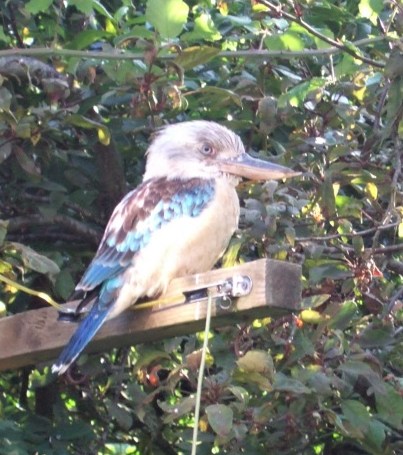
Mystery
Hornet
Graham Petrie
suggests that the unusually large Hornet captured by
Chris Oakley on June 22 could be a Hornet Moth. That's
interesting, though my money is still on a standard
Hornet. Here is one of Chris's original Hornet photos
(left) and a Hornet Moth from the internet (right)
which shows quite different abdomen markings and wings
to Chris's insect.
SATURDAY
JUNE 23 - 2018
Huckswood
Lane
Heather Mills
reported on this morning's walk by the Havant Wildlife
Group
5 met on a gloriously sunny morning and ventured first
to see if we could hear a Turtle dove in the vicinity
over the railway bridge, towards the horse paddocks.
Alas we were unsuccessful.

However, Tony had
spotted a contented pig, serenaded by Guinea fowl,
sunning itself in an adjoining field.
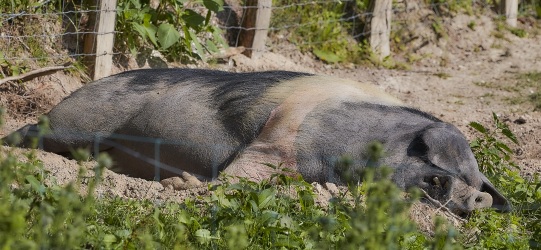
We had a good chorus
of birds singing including a Song Thrush and a
Blackcap male which for once could be seen in a nearby
bush. Further on we had a treat in seeing a couple of
hares out and about. An occasional snatch of
Yellowhammer could be heard but our real enjoyment
came when we walked in view of Uppark to our right and
Ditcham Park on our left with about 15 Skylarks rising
and falling above a crop of broad beans either side of
the footpath. Their glorious song rang out in a clear
blue sky and it looked like the juveniles constantly
chased the parents above the crops.
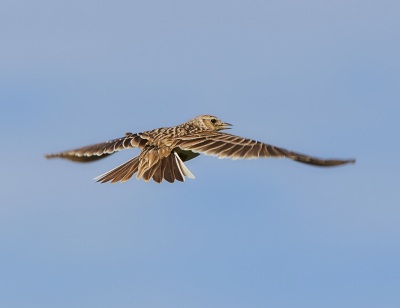
This footpath through
the crop produced some intriguing wild plants. Spotted
by Caroline as being different to the norm were Small
Toadflax, Wall Speedwell identified by Ros, and
Henbit Deadnettle amongst other usual Red,
White and Bladder Campion, Common and Prickly poppy,
and a Musk Thistle with Field Pansy,
Field Madder and Scarlet Pimpernel.
The butterflies were
not in great profusion but we did manage to see
Dark Green fritillary, Ringlets, Brown Argus,
Small Tortoiseshell, Large White, Large Skipper,
Meadow Browns, Speckled Woods, Commas, Red Admirals
and White Admirals with last but not least, a
Gatekeeper.
Silver Y were evident
and a few grasshoppers including I think a Roesel's
Bush cricket. A Mullein moth caterpillar
too.
Caroline's mystery
bug
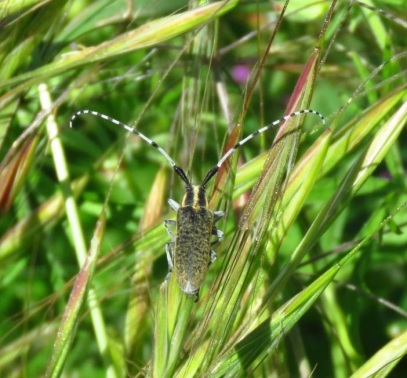
Although some of us
could recall the days when Corn Bunting sang not far
from this farmland it was a morning worth spending in
communion with nature at its best.
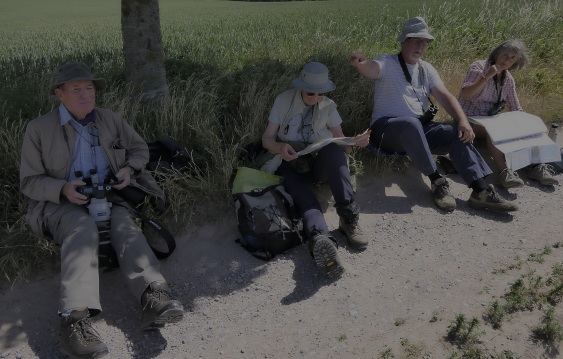
Brian's
notes:
Yes, the grasshopper is a Roesel's Bush-cricket
- fairly common on Brook Meadow.
I tracked down
Caroline's mystery bug as the wonderfully named
Golden-bloomed Grey Longhorn Beetle
(Agapanthia villosoviridescens). Said to
be widespread in grasslands.
A great report and
wonderful photos. Well done!
FRIDAY
JUNE 22 - 2018
Langstone
Mill Pond
Peter
Milinets-Raby felt the first real hints of autumn
today. The news from Langstone Mill pond (over the
last week) has been as follows:
On the mud today was a Whimbrel - the first
wader I've seen for a couple of weeks (except for
about 3 Oystercatchers), plus a first summer Med
Gull moulting (see photo) and the first juvenile
Black-headed Gull was observed on the mud, pestering
its parents.

Tufted Duck numbers
have settled at 3 males and 2 females. I think one
female has hidden herself away to breed.
At least 27 juvenile Little Egrets are present. They
will be moving on in a couple of weeks and the colony
will be quiet. Young Grey Herons are everywhere (see
photo).

There are still 3
Great crested Grebes around along with 2
Shelduck
Large
Hornet?
Chris Oakley
caught this very big Hornet in his conservatory this
evening - some 4cms long. There is very little red
around the thorax, but it was just the sheer size that
seemed wrong.
That's a strange one.
Hornet is the largest wasp that I know of. Can anyone
solve this puzzle?
THURSDAY
JUNE 21 - 2018
Brook
Meadow
Nine
volunteers assembled at the new tool store (HQ) on the
Seagull Lane patch for the regular third Thursday in
the month work session led by Colin Brotherston.

The main tasks
involved clearing the paths on the Seagull Lane patch
and the area in the north-east corner of the north
meadow using the power scythe. Other volunteers
cleared the Rowan plantation which had become engulfed
by bindweed. Jennifer entertained an ecologist Nick
who was organising a reptile survey with a view to
another translocation onto the meadow from a
development site in Warsash. Nick is shown here during
coffee break with Dan and Jennifer.

I went along the path
by the river with Dan to make a list of the existing
plants on the river bank, not an easy job with the
burgeoning growth of nettles and bindweed. Dan is now
in charge of the Water Vole restoration project and is
considering bringing in a few new plants onto the site
to enhance the habitat. However, I wonder if new
plants are really needed with at least 45 plants
recorded today. It strikes me that the problem for
Water Voles is not food; there is plenty!
A full report with
more photos will shortly be on the Brook Meadow web
site at . . . https://www.brookmeadow.org.uk/conservation-group-news/
Wildlife
observations
The first
Meadowsweet of the year was in flower. I am
looking forward to more of this aromatic plant. Also,
masses of green berries are forming on the
Rowans on the east side of thee north meadow.
TUESDAY
JUNE 19 - 2018
Slipper
Millpond
I had a walk
around Slipper Millpond this afternoon where I was
interested to see that the pair of Great
Black-backed Gulls were on the centre raft with
their two growing youngsters. It should not be too
long before they take their first flights, if they
have not done so already.

This is not the raft
on which they nested, though I am sure they must
hanker for it as they did nest there for 5 years from
2012-2016 before being ousted by a pair of Canada
Geese. The Great Black-backed Gulls have nested on the
south raft for the past two years.
Here is a short video clip of the youngsters that I
took today . . . https://youtu.be/RxY_fWSnS8A
Far more spectacular
was the massed bathing of mainly Mediterranean
Gulls on the pond. It is not unusual to see gulls
bathing in the clean water of the pond after a day
foraging in the fields, though to see so many
Mediterranean Gulls was a real treat. I countd 34 in
this photo, thought they kept coming and going all the
time.

Here is a short video
clip of the bathing frenzy that I took today . . .
https://youtu.be/4uc-mZ7OKWw
Meanwhile, the Mute
Swan family with four cygnets from the Peter Pond
nest was sailing serenely down Dolphin Lake, all
looking in fine fettle.

One final observation
was my first Perennial Sow-thistle flower on
the east side of the pond.

MONDAY
JUNE 18 - 2018
Brook
Meadow
The first
thing I noticed on this morning's stroll through the
meadow was the pink flowers of Great Willowherb
just starting to open - about the same time as last
year. I have a soft spot for Great Willowherb as it
was the first and main invasive plant the Brook Meadow
Conservation Group had to grapple with when we took
over management of Brook Meadow in Year 2000. The
meadow was literally covered with it, but annual
mowing gradually reduced its hold. There is still
plenty of it to enjoy and for the insects to feed on.

While mooching around
the orchid area without any particular purpose in
mind, I was very surprised to come across a single
Pyramidal Orchid its bright pink flower spike
standing out quite prominently from among the mass of
vegetation that has recently engulfed this area. You
can't miss it. I have marked it with a tall stick just
in case. Grid Ref: SU 75070 06153.

This was the first
sighting of a Pyramidal Orchid on Brook Meadow since
Richard Somers Cocks discovered one in the same
general area on June 23 2010. I believe a Pyramidal
Orchid was planted on the orchid area by Jennifer Rye
in 2008, but there has been no sign of any since then
(apart from Richard's) until today. I suppose the
seeds could have been lying dormant waiting from the
right conditions. I had a good look around but could
find no others.
Most of the other
orchids are now well past their best, though I did
find one Bee Orchid with three flowers still
going strong.
Some of the Yellow Rattle plants are now
forming seed pods with the rattling seeds which gives
the plant its common name.
I got a photo of this
Meadow Grasshopper as it paused briefly on a
leaf
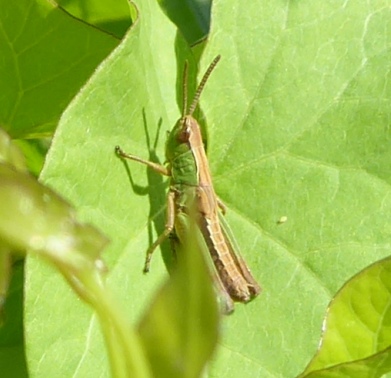
There is an impressive
bank of well nibbled Butterbur leaves near the Lumley
gate.
They are well loved by children for making
umbrellas.
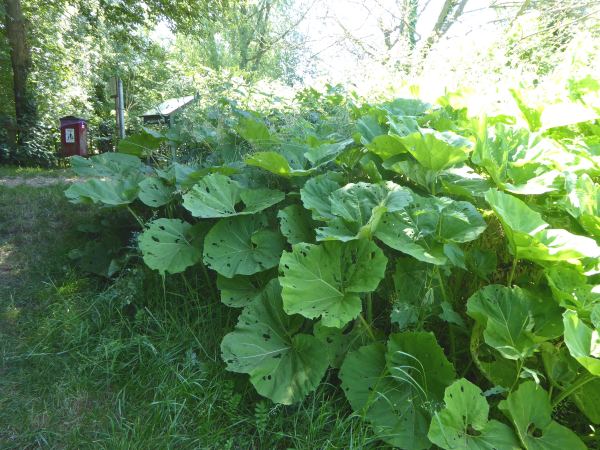
For
the previous month go to . . . June
1-16